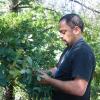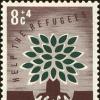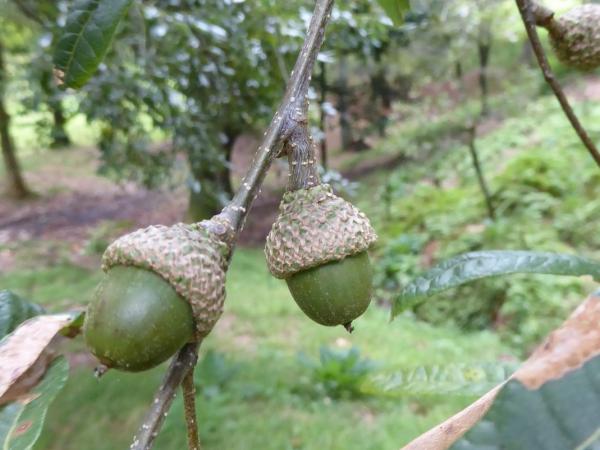Editor's Picks
Plant Focus
2018 Post-Conference Tour #2: Central Coast
The first Post-Conference Tour ended in Cupertino. The smaller group that continued on the second Post-Conference Tour drove south to Santa Cruz where we spent the night. At 8:00 am the next day we boarded the two remaining UC Davis vans to drive south for the next leg of our journey. It took us over three hours, with one stop along US 101, to get to the Halter Ranch Winery near Paso Robles.
Several oak species were present on the ranch, but we were here to see a Red Oak, the “world’s largest known coast live oak" (Quercus agrifolia). Dr. Matt Ritter, our guide for the day and a Biology professor at Cal Poly in San Luis Obispo, uses a neat device called a clinometer to measure height and spread. It has three high-powered lenses and uses the lenses’ focal length to calculate distances. Our tree was 91 ft high (nearly 28 m) and 105 ft (32 m) wide, with a girth of 27 ft (8.23 m).


We then drove to our next stop, Peachy Canyon, through a riparian forest of Q. agrifolia and Q. lobata, with an occasional Q. douglasii. Somewhere along the road we saw a hybrid oak, Q. lobata × berberidifolia, which had the size and form of Q. lobata and the leaves of Q. berberidifolia.
We came to Peachy Canyon Road mainly to see the relatively rare Palmer oak (Q. palmeri). But there were also great specimens of Q. berberidifolia, one of the most common scrub oaks in California. There is also a huge diversity in shape and size of their acorns. We had lunch in the shade of the tallest Q. berberidifolia.
After lunch, we walked down the road to look at Palmer oaks growing by the side of the road. Like Q. chrysolepis, Q. palmeri is an intermediate oak (Section Protobalanus). Although Q. palmeri is thought of as a shrub oak and not a tree, specimens here were around 5 meters high. Then we boarded the vans again to drive to Los Padres National Forest.
Part of East Cuesta Ridge burned in 2015, but Q. agrifolia and Platanus racemosa generally survived the fire. The dominant oak around us was Q. agrifolia with an occasional Q. wislizeni. On serpentine, we could see Q. durata, which tends to occur only on this type of soil. We also found small plants of Notholithocarpus densiflorus.
The next day we drove to Morro Bay, which we could see from the East Cuesta Ridge the day before. Our destination was El Moro Elfin Forest, a 90-acre State Park in Los Osos. Matt Ritter had told us that the climax community on this old Pleistocene dune was an oak woodland of Q. agrifolia and that at one point they had been called Q. agrifolia var. frutescens because of their shrubby habit. However, one of his colleagues at Cal Poly, Robert Hoover, had demonstrated that this should be regarded as a synonym of Q. agrifolia and that mostly edaphic factors determined their habit.
The Santa Barbara Botanic Garden, where we drove after lunch, was founded in 1926 and has increased in size over the years, currently covering 78 acres. It specializes in plants from the California Floristic Province, of which it has over 1,000 taxa. We started at the Meadow, a beautiful plot where we stopped first for a good specimen of Q. engelmannii. Our attention was also drawn to fine specimens of Q. agrifolia.

We then drove to Hendry's Beach in Santa Barbara to wait for the sunset and had dinner in the center of this picturesque town. Before leaving town the next morning, bound for Arcadia in Greater Los Angeles, we had one more stop at an old restaurant turned fitness center, built around the Witness Tree, a 300-year-old California sycamore, Platanus racemosa.

Upon arrival in Arcadia, we stopped very briefly on Fallen Leaf Road to see remnant pre-development Q. engelmannii lined along the street.

Our guide for the day at Los Angeles County Arboretum and Botanic Garden was Jim Henrich, curator of living collections. The Engelmann Oak Grove was clearly the highlight of our visit. In the 2017 Red List of US Oaks Q. engelmannii has been placed in the Endangered category. The Arboretum has 224 mature trees, 175 in the grove alone, the rest being scattered throughout the site. A mast year occurs every three years, and in 2013 and 2016 Jim and his team collected acorns from the trees, keeping track of which tree the acorns came from. They then sowed the acorns and replanted the resulting seedlings in the grove under each parent tree.

Our thanks go to Rachel Davis and David Muffly, who planned and led this Tour, and to Miles DaPrato and Ryan Deering, as well as to Dr. Matt Ritter and Jim Henrich, who were generous with their time and shared their passion with us.

A detailed Tour report will be published in the 2019 issue of International Oaks (Proceedings of the 9th International Oak Society Conference). You can view more photographs of this Tour in a photo gallery here.
Photographs © Charles Snyers unless specified











